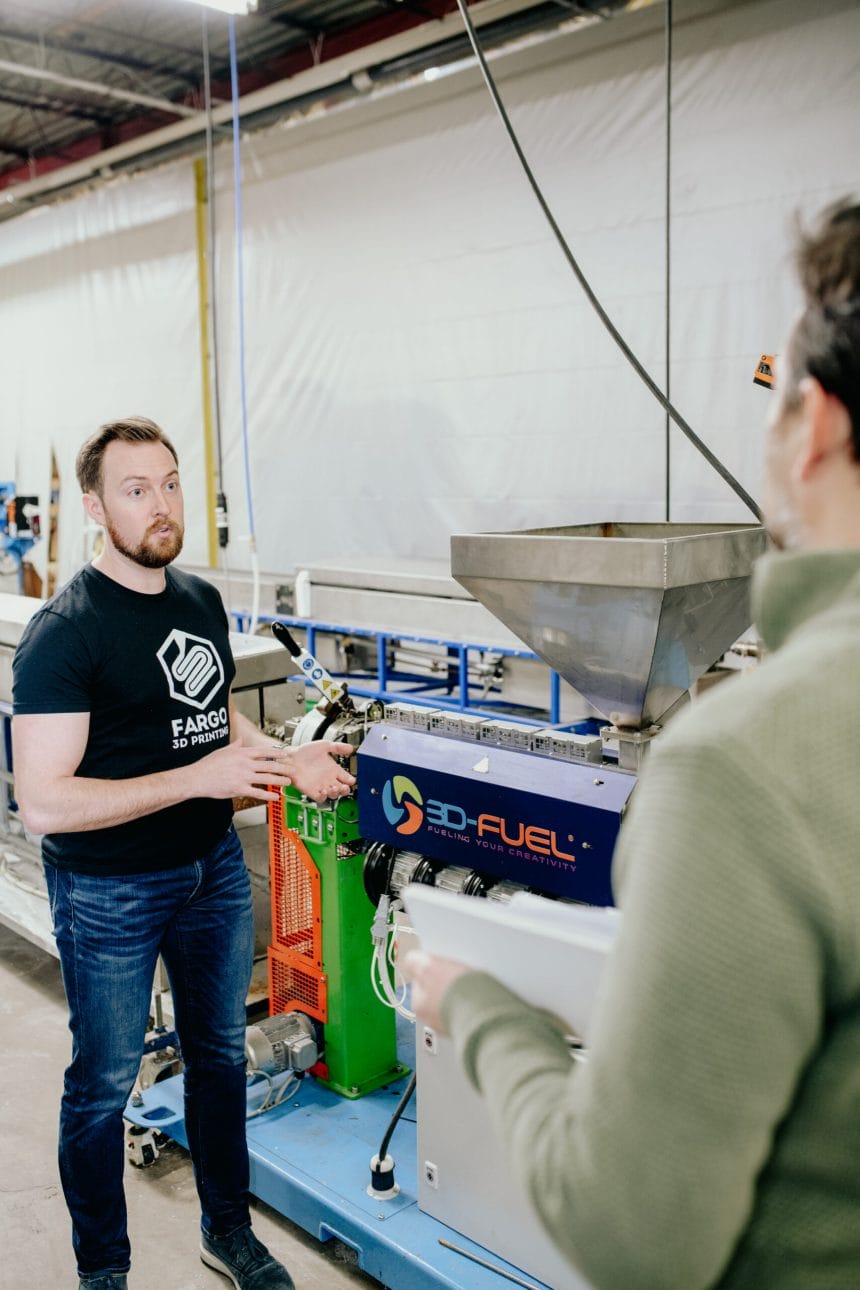John Machacek, Chief Innovation Officer for the Greater Fargo Moorhead Economic Development Corporation, has worked with countless startups throughout our community over the past nine years. He knows their ups, their downs, but most of all, he knows the questions to ask them. Here are John Machacek’s 10 questions for John Schneider, Co-Founder of 3D-Fuel and Fargo 3D Printing.
1. Will you please tell us your 3D-Fuel and Fargo 3D Printing elevator pitches?
Fargo 3D Printing focuses on helping people in the tri-state area get started with 3D printing, stay with 3D printing and (hopefully) change the world! We do that by providing pre-built and calibrated 3D printer kits, 3D printing materials from 3D-Fuel, upgrade and replacement parts–all with advice and guidance from our 3D printing experts. Fargo 3D Printing also provides custom 3D printing and design services for those that need parts–fast!
3D-Fuel empowers your 3D printing success by providing THE premium 3D printing experience. We do this by manufacturing high-quality, reliable 3D printing materials right here in Fargo, and by providing exceptional customer support and advice in an industry that many times raises more questions than it answers. We pick up the phone, answer chats and emails and won’t rest until we help you bring your ideas to life.
2. That is two entirely different companies under one roof but they are complementary of each other. I’m guessing a basic synergy is that Fargo 3D Printing can sell your manufactured 3D-Fuel filament products. Are there other synergies of owning both of these and having them co-located?
You’re absolutely correct, John, that one of the biggest synergies is that Fargo 3D Printing is able to sell filament manufactured by 3D-Fuel right in our local area. One of the other massive benefits is that we have Fargo 3D Printing employees that are very skilled in 3D design and, of course, in 3D printing itself. When we are looking to solve a problem out on the 3D-Fuel production floor, many times there is not an off-the-shelf solution. We have unique problems, so that requires unique solutions. It could be a production operator informing his manager that “there’s got to be a better/ faster/easier way to do this, but we’d need a part like THIS”.
Our plant manager will then reach out to one of the Fargo 3D Printing folks to see if there is something that they can design and, if it makes sense, 3D print to be that unique solution. We also “eat our own dog food”, so to speak. We 3D print every single day at Fargo 3D Printing using 3D-Fuel materials. If there are any product quality concerns or 3D printer settings that we notice work really well with 3D-Fuel materials, that kind of feedback can go directly to the production floor or to our customer support team.
3. Speaking of synergies, I interviewed c2renew last month and we discussed the region’s interesting, integrated 3D printing ecosystem. How does this dynamic ecosystem we have play a role in your operations?
It’s kind of funny, actually. We’ve been getting that same type of question from others in our industry, “Why is there so much 3D printing activity going on in Fargo?!” The short answer is that it’s been a 10-year overnight success story. I joke, but only sort of.
I remember back in 2012 purchasing my first laser-cut wooden 3D printer kit for $400 (a Printrbot Jr V2, for those interested) and thinking how cool it would be to have one of the nice, $2k+ 3D printers to tackle larger projects. I reached out to Ben Bernard in the NDSU Architecture department as I had heard they were working with 3D printers. From there one thing led to another, I opened a makerspace and met my business partner for Fargo 3D Printing. Skip ahead 8-9 years and we now have a diverse ecosystem of 3D printer manufacturer, consumer marketplace, materials manufacturing, and materials research. Add all of that to the fact that it is incredibly easy to do business in ND and to be supported by various programs from the Bank of North Dakota, the SBDC, and the GFMEDC and it’s a wonderful story of right place, right time, right preparation.
4. With 3D-Fuel, you offer many varieties of colors, sizes and materials for your filaments. What stands out as your most popular?
With thanks to the prior mentioned c2renew and their composite materials, we sell some very interesting filaments infused with materials such as coffee, hemp, beer and more. However, our most popular products are the Pro PLA+ filaments. They are derived from corn and are 100% biobased. They come in 40 colors, are tough and print very well. Our customers also appreciate that our products are 100% originated in the USA and they love that we have a very knowledgeable, US-based customer support team. They can pick up the phone or use our chat function to ask questions and get advice. By far, however, our most popular color is Midnight Black and our most popular material is Pro PLA+.
5. Then with the 3D printing side, you obviously sell a lot of printers, parts and filaments, but you also do custom 3D printing. Can you please tell me more about that component of the business?
We have done custom 3D printing projects as small as just one unit but have also undertaken projects where the unit count was in the 10,000s. Right now, we’re working with a large equipment manufacturer that is running into supply chain issues with the electronics components that are in each piece of equipment. Rather than completely halt their production, they are assembling 99% of each unit and then placing them outside in parking lots until the delayed electronic components show up. Until then, they need to protect all of the electrical connectors from the elements. Enter 3D printing. They provided the 3D design file to us; we were able to print parts for a test-fit within 24 hours and the next day they placed an order for thousands of units and we were able to start delivering on that order within a week. You simply can’t do that with any other manufacturing method. If you went to injection molding, you’re looking at months and tens of thousands of dollars just for the injection mold tool to be produced. That’s not even including the time necessary to produce the parts! 3D printing really is changing the way and the speed that manufacturing can be done.
6. What has changed about the 3D printing industry and what excites you about its future?
The industry is being taken much more seriously now and not looked at as much as a hobbyist thing. Of course, there are more hobbyists than ever, too! A much broader realization from manufacturers that it can be used for producing final parts, not just for prototyping or for jigs and fixtures. Large format 3D printing will really come into its own soon. Also, the exposure to youth and college students over the years is leading to more knowledge and comfort with the tools and as these people continue to enter the workforce, it should continue to grow this.
7. Any advice for others, whether individuals or schools or novices, about what early steps they can take to learn more and get involved with 3D printing?
There is so much content out there. It’s crazy how much excellent 3D printing content exists on YouTube and other platforms. When I first got started with 3D printing in 2012, I immersed myself in all of the content that I could and I was very active in the then Google+ 3D printing community. It got to the point that I was answering new member questions even before I had a 3D printer in my hands! There was so much content even at that early time that a person could be offering useful advice without ever having used a 3D printer. Now take that, add 10 years’ time with improvement in 3D printers, software, and content quality and you have a wealth of options to learn from. There are also classes available locally to get your feet wet with hands-time on 3D printers and, of course, we are more than happy at Fargo 3D Printing to walk you through getting started with your first 3D printer and to have it assembled and calibrated for you to start off on the best foot possible!
8. We first met, I’d say about 9 years ago, around the time you were creating your makerspace. So, from a makerspace to now a manufacturer, what are some key things you learned over the years?
Community should come first. This was the case with MELD Workshop (makerspace) and it’s the case with the 3D printing industry. I did things the wrong way with MELD. I took a Field of Dreams approach after being encouraged by the local startup community to follow my dreams and build a space. The startup community is great, don’t get me wrong, but you should have a community of customers ready to go before starting up a space like that. Words are nice, dollars are what keep the doors open on something like that. Some of my most engaged members I had never met prior to opening the space. 3D printing is similar – many of our customers are extremely active in their own groups and subgroups in the 3D printing community. We also do our best to engage in those communities – our customers really enjoy and respect that and it helps to create that long-term customer relationship rather than just a one-time transactional relationship. We also like to elevate our customers and show our community the things that they’ve been able to do with 3D printing–it’s amazing what businesses, organizations and individuals are doing with 3D printing!
9. In that vein, if you could go back in time to John from several years ago, what hindsight advice would you give yourself?
Don’t be afraid to ask for help when you need it. I was, and still am, incredibly stubborn and want to prove that I can do it without any help. That’s a terrible approach. You can’t possibly be an expert at everything and asking for help doesn’t mean that you are failing at an aspect of your business. It means that you have the self-awareness to recognize that for your business to succeed and thrive you need to get the heck out of your own way. People generally want to see you succeed, but you can’t wait for them to offer help. They may have no way of knowing that you want or need it.
10. What can we do as a community to help 3D-Fuel and Fargo 3D Printing succeed?
Words are nice, but dollars are better. First of all, if you’ve been considering getting into 3D printing as a hobby or to help you meet business objectives, stop into Fargo 3D Printing. We have a great team here that is excited to help you succeed. Okay, I said that words are nice, too: if you have someone in your life who is in manufacturing, higher education, government purchasing, etc. who cares about a secure, USA-based manufacturing supply chain, tell them about 3D-Fuel. We are as US-based as you can possibly be. Our PLA filaments use US-grown corn to turn corn into plastic down in Blair, Nebraska. We then turn those pellets into filament in our Fargo facility. Our box supplier is in West Fargo. Our spool supplier is in Fergus Falls. Many of our other miscellaneous packaging is from a Wisconsin company. And, of course, our sales and customer support team in based right here in Fargo. Get in touch with us – we’d love to tell you more!
About John
John Machacek has been helping local startups with the Greater Fargo Moorhead Economic Development Corporation since prior to his position with the GFMEDC. Before joining the team, Machacek was the VP of Finance & Operations at United Way of Cass-Clay and a business banker at U.S. Bank.








